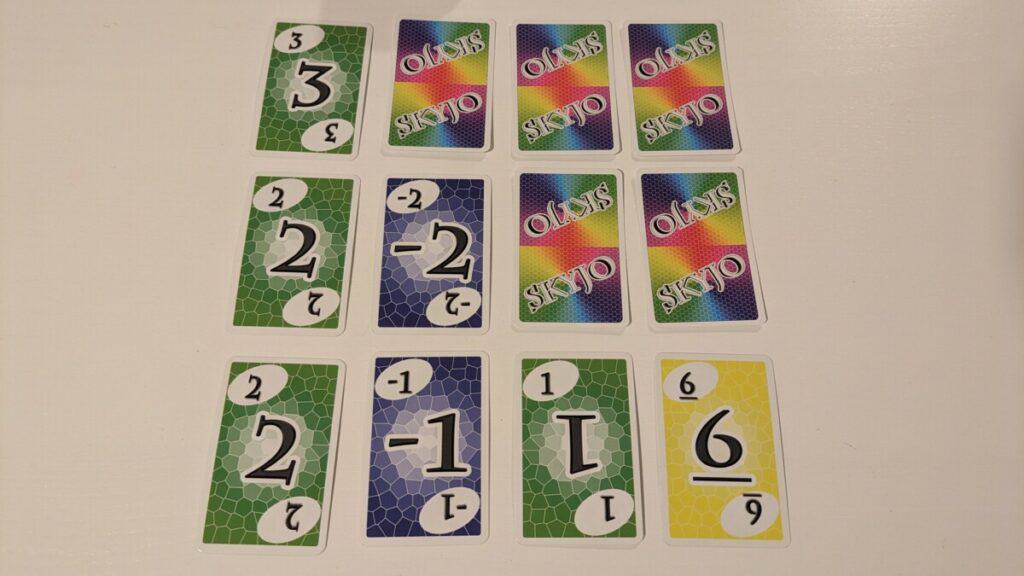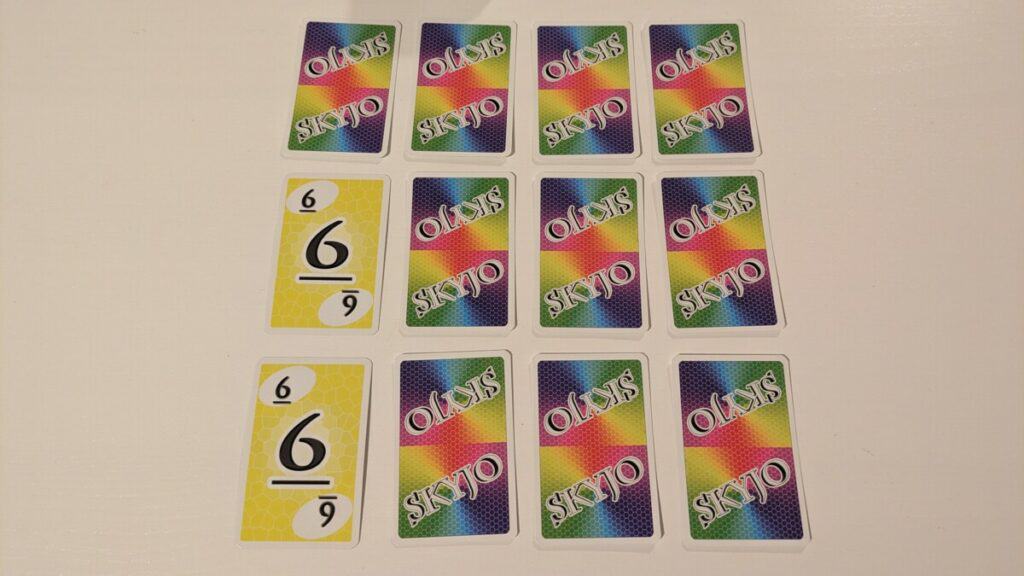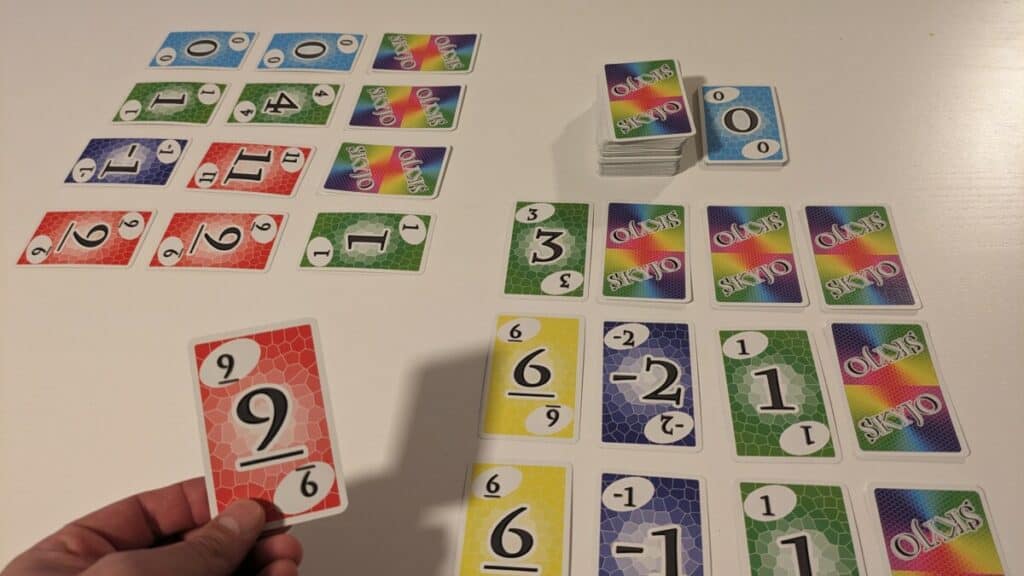
Skyjo is a relatively new game based on the popular card game ‘Golf’. My family and I enjoyed playing Golf quite a bit so we decided to give this colorful and expanded version of the game a try. To my delight, there was a surprising amount of strategy to be found combined with the luck of the draw. These Skyjo strategies will make you a better player and help you to win more games.
In general, the best Skyjo strategies are to only keep cards with values 4 or lower, utilize the ability to eliminate columns, and focus on the longer game instead of individual rounds. You should strive to reveal up to 9 cards early in the game, but leave some cards face down to give you options later on.
Like most fun games, Skyjo combines a healthy mix of skill, strategy, and luck. The strategies I list below may not all be completely intuitive, but I’ll dive deeper into ‘how’ and ‘why’ to apply these tips in your own Skyjo games so that you have more fun while winning more games.
Decline to keep cards 5 or higher
When you draw a card from the center draw pile you have the option to discard it or keep it by replacing one of your cards. We can use some simple math to tell us which card we should keep and which we should discard, all else being equal.
The distribution of cards in Skyjo is as follows:
| Card Value | # of Cards |
|---|---|
| -2 | 5 |
| -1 | 10 |
| 0 | 15 |
| 1-12 | 10 |
If you draw a 5 or higher then you should discard it, because you have a 50% chance of flipping a card with a value less than 5. You may get unlucky and end up flipping over a card worth more than 5 points, but then at least you know it’s a card that needs to be replaced.
It’s probably not a coincidence that Skyjo has themed their cards right on this cutoff. Cards with values 5 through 8 are yellow, while cards 9 through 12 are red. Everything 4 or below is a pleasant shade of green, blue, or purple. You can use this cutoff as a quick reminder of when to discard a card you’ve just drawn – yellow and red should be placed back on the discard pile.
Have a column dedicated to negative numbers

In Skyjo it’s nice to have columns dedicated to certain types of cards or strategic objectives. If you turn up a -1 or -2 then you should try to designate that column as the place where you’ll collect any additional negative numbers you draw.
By grouping your negative numbers in a single column you give yourself a higher likelihood of being able to eliminate the other columns. You can stack positive numbers in other columns hoping to get rid of them through column elimination without having to replace a negative number to do so.
Avoid losing out on negative numbers
If you do decide to focus your negative numbers into a single column you should be cautious about not eliminating the column altogether. Usually, it’s a big advantage to eliminate one of your columns, but in this case, you’d be missing out on a lot of valuable negative points.
CHECK IT OUT: Do you like playing Skyjo and other card games, but hate carrying them around in flimsy cardboard cases? Check out this handy hard shell case on Amazon!
If you end up in a situation where you have two -1’s or two -2’s showing in a column and the third card is still face down you should prioritize replacing the face-down card with one you draw from the center. You don’t want to be surprised with a matching negative number card if you flip it over, losing the entire column!
Flip two cards in the same column to begin

Through many rounds of play, I have found that at the beginning of the game, it’s usually more beneficial to flip over two cards in the same column than to flip one card each in two separate columns. This advantage is usually very short-lived since many more cards tend to get revealed early in the game, but it has the potential to be game-changing.
It’s more useful to have 66% of the information about one column than it is to have 33% of the information about two columns. If the two cards you flip over in a single column happen to be the same positive number then you can try to leave the third card in the column unflipped until you find a third card to match them, thereby eliminating the entire column.
Reveal a lot of cards early in the game
Early in a game of Skyjo, you should tend to prioritize gathering as much information about your cards as possible instead of swapping out high-numbered cards. Many newer players rush to swap out any 10’s, 11’s or 12’s, but there will be plenty of time to get rid of these cards in the future.
It’s usually best to continue flipping cards so that there is less hidden information. Sometimes you discover that you can get rid of those high-numbered cards by simply eliminating the column. You can also begin to prioritize which cards get swapped out first because there is no guesswork.
Avoid going ‘out’ first unless you’re sure
Going ‘out’ first in Skyjo is a risky venture. Unless you have significantly fewer points (I would say 12 or more) then it is probably too soon to go out and finish the round. There is always a risk that your last card will be a 12 while your opponents can luck into low-value cards or even eliminate an entire column.
The penalty for going ‘out’ first and not having the fewest points is having your points doubled. This is often a game-losing mistake, especially if you’re rushing to go out with a lot of points.
Aside from a few fringe cases (see below), it’s best to delay going out until you are sure that it’s mathematically certain that you’ll have the fewest points. You should try to let other players assume the burden of going out first so that you don’t run the risk of having your points doubled.
Play to win the game, not the round
Skyjo is usually played until one player accumulates 100 points or more. This can be adjusted according to agreed-upon house rules, but this strategy tip still applies. Don’t forget that a game of Skyjo consists of multiple rounds, and it doesn’t matter who wins one particular round.
Sometimes it becomes apparent that one of your opponents is about to go out and end the round, but you still have a lot of points showing. In this case, you should do your best to ditch as many points as possible, abandoning any hope you had of eliminating a column or replacing all of your high-value cards. Remember that sometimes it’s better to lose small than it is to try to win every round.
Put an opponent over the limit to win the game
Keeping in mind that a game ends as soon as one or more players go over the point limit (usually 100 points), sometimes it’s best to go out and end a round even if you don’t have the lowest score.
Let’s examine the situation below:
| Round | Player 1 | Player 2 | Player 3 |
|---|---|---|---|
| 1 | 3 | 16 | 6 |
| 2 | 6 | 2 | 8 |
| 3 | -1 | 38 | 19 |
| 4 | 8 | 12 | 11 |
| 5 | 2 | 11 | 24 |
| TOTAL | 18 | 79 | 68 |
In this game, Player 1 has such a large lead that they should be looking to end the round as soon as possible if Player 2 is showing over 21 points. As long as Player 1 doesn’t have a ridiculous number of points showing, they can afford to have their points from this round doubled and still win the game.
Don’t pass beneficial cards to your opponent

One of the most basic (but important) strategies in Skyjo is to avoid helping your opponent with beneficial cards. This tip is easy to understand but is still often forgotten by new players who tend to focus on their own cards.
Always be watching the cards of the player to your left, to whom you’ll be discarding cards. Obviously, you always want to avoid passing low-value cards to your opponent, but you also want to see if they’re stacking numbers in a column in an effort to eliminate it. If you see that they have two 6’s in one column you should try to avoid discarding a 6.
Use higher-value cards to get rid of a column
Most new players try to focus on swapping out high-value cards for lower ones, even if the benefit is marginal (swapping in a 9 for a 12, for example). A more powerful strategy is to choose a column early in the game in which to ‘collect’ mid- or high-value cards, planning to eliminate the column entirely by matching them all together.
There is less risk in the strategy with mid-value cards than there is with high-value ones because they simply aren’t worth as many points. The flip side of this is that other players are much more likely to discard high-value cards than they are mid-values. For example, you’re much more likely to get a ’12’ discarded to you than a ‘6’, especially late in the game. If you already have two 12’s stacked in a column this can play to your advantage.
Leave yourself with options late in the game
Games of Skyjo usually end because one player decides it’s more detrimental to discard a particular card than it is to swap one out. This happens because they have left themselves with only 1 card left to flip, so choosing to discard a drawn card ends the game.
You can avoid being forced to go out first by leaving yourself with more options late in the game. It’s generally best to always have at least 3 unflipped cards in your hand so that you have a buffer when making your decisions.
As a general rule, I like to have one more unflipped card than my opponents. This isn’t always possible, but it’s a good goal.
Sit to the left of an inexperienced player
This tip applies to most card games and board games, but it’s just as powerful in Skyjo as it is in any other game. It’s a definite advantage to sit to the left of a new player because they won’t be as familiar with the rules and strategy of the game. They likely won’t pay as much attention to your cards as more experienced players would, so they are more likely to pass beneficial cards to you.
Bearing this in mind, you can sometimes make decisions about which cards to keep in the hopes of eliminating a column. If the inexperienced player to your right is showing multiple 7’s face up, you can safely assume that they will be looking to discard those 7’s in the near future. If you can manage to start stacking 7’s in one of your columns then it’s likely you’ll be able to eventually eliminate that column.
Thanks for reading! If I missed something or you have your own opinions, please drop a comment below.
You would only get to draw and play a Sanctuary card on turn two of round one if the Region…
Rule question. If in phase one of round one I play a Region card with a Clue symbol at the…

Leave a Reply